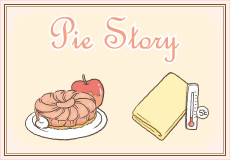
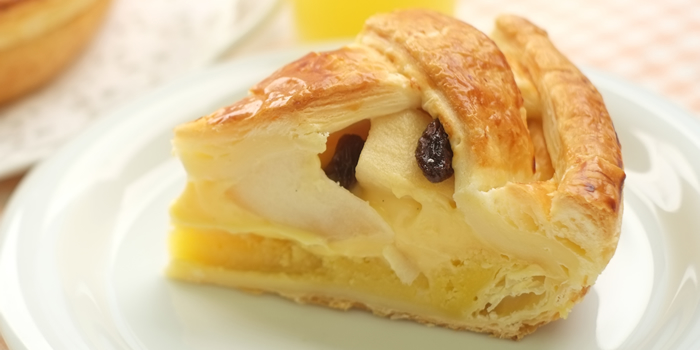
 Mechanism of puff pastry
Mechanism of puff pastryPuff pastry is light, crisp, and voluminous.
The state of the dough layer and the fat layer greatly affects the mouth feeling. By regularly folding the thin dough layer and the fat layer, the fat layer and the dough layer do not stick together, and the water vapor and carbon dioxide generated from the dough during baking will swell up greatly.
The state of the dough layer and the fat layer greatly affects the mouth feeling. By regularly folding the thin dough layer and the fat layer, the fat layer and the dough layer do not stick together, and the water vapor and carbon dioxide generated from the dough during baking will swell up greatly.
 How to make a pie dough
How to make a pie doughThere are two method to make puff pastry, French method (Puff pastry dough) and Scotch method.
|
French method pie Before folding, the dough is cooled, then stretching with a rolling pin or pie roller, after that, wrapped the margarine sheet (butter sheet) in the dough and stretched and folded, then again 3times. After numerous layers of fats are formed, the dough is cooled again and rested one night, then cut into an appropriate shape and baked. Folding pie is also called “Feuilletage”. |
|
Scotch method pie In advance, cold butter or margarine have been cut into small pieces and then mix with flour slowly until small grain of butter or margarine. After that, add water and eggs, cool the dough again, rest it one night, sheeted, shape it into an appropriate shape, and bake it. A sweet kneaded dough with added sugar is called " Pâte Sucre ", and a kneaded dough without sugar is called " Pâte brisée ". A sweet dough is used for tartlets and foundations of Western confectionery. Non-sweet dough is widely used for confectionery and cooking. |
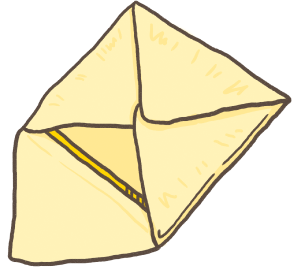 |
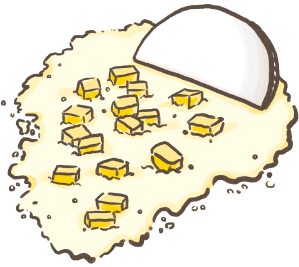 |
|
| French method pie | Scotch method pie |
 Low temperature for puff pastry dough making
Low temperature for puff pastry dough making| To make puff pastry dough, it is important to keep the dough temperature low. If you don't cool the dough after wrap, the physical property balance between the margarine or the butter and the dough will deteriorate, and the laminated state will collapse. Therefore, it will be a point to rest the dough and keep the temperature as low as possible. In addition, during folding, it is important to keep the dough as cold as possible and to work in a short time. |
 |
 Raw materials of pie dough
Raw materials of pie dough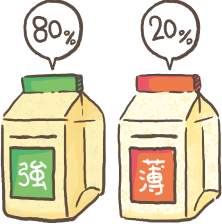 |
In general, the basic composition of Puff pastry dough is wheat flour, salt, and margarine or butter, but eggs may be added. The butter is mainly used, but margarine is sometimes used. For wheat flour, combine strong flour and soft flour. The best blending ratio is 50-80% for strong flour and 20-50% for soft flour. Increasing the proportion of soft flour improves the mouthfeel lighter but makes lift performance worse. the puff pastry at confectionary shops may have a fat content of 80-100% of 100% flour (bakery percent) |
 Handling of puff pastry dough
Handling of puff pastry dough| Even if there was no problem when making the puff pastry dough, dark brown spots may appear on the surface of the dough during refrigerated storage. This is often seen when the dough is thawed and stored refrigerated or when the dough is stored refrigerated for a long time. This may be due to the oxidation of carotenoid pigments in wheat endosperm (light cream colour of wheat flour). Non-enzymatic oxidation and enzymatic oxidation by oxidase proceed in a complex combination. This change is greatly affected by humidity, so you should be careful when refrigerated after thawing for keep. It is most effective to use up as soon as possible after thawing. |
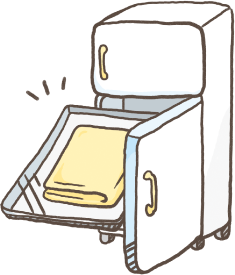 |
 The history of pie
The history of pie |
Generally, it is said that a pie has started in the ancient Greek and Roman eras, and so as not to miss the taste of the meat and fruits and not to expose an open fire, and meat and fruits were wrapped in a dough that combines flour and fat. Later in France in the 14th century, “Feuilletage” (puff pastry) emerged, and the pies “pate” wrapped with meat, fish, vegetables, fruits, etc., was baked in an oven. There is also a theory that the French confectioner Feuille made the confectionery using puff pastry dough in the 17th century and was named “Feuilletage” (puff pastry). There is an interesting theory that Pie, which means “magpie” in English, is similar to a magpie that collects anything and a pie that wraps everything. |
 Various pies
Various pies
In the UK, pie has a long history, including pie baked together with meat, fish and vegetables, sweet pie baked together with fruit and cream on pie bowl, and pot pie baked with pie dough on bowl.
In the old days, it was used as a vessel for fillings and was thrown away when cooking was done. This is because there were no oven moulds or dishes like today, so the pie was playing that role.
In addition, it is said that “Apple Pie”, a familiar pie, was born in the UK.
Apple pie in France is an "apple tart".
There were sisters called Tatin in the old country town of Orleans, France, and one day, she made apple tart for dessert. When she tried to take out of the oven after it was baked, the tart was turned over for some reason. She felt frustration because it was a pie that was made with great effort. Then, she put it in her mouth, it turned upside down, and the surface baked with a baking sheet turned into a caramel-like surface that was delicious, and it had a delicious taste. Since then, this sweet has been turned over and baked from the beginning, so it is called “Tart Tatin” and has become one of the traditional French sweets.
In the old days, it was used as a vessel for fillings and was thrown away when cooking was done. This is because there were no oven moulds or dishes like today, so the pie was playing that role.
In addition, it is said that “Apple Pie”, a familiar pie, was born in the UK.
Apple pie in France is an "apple tart".
There were sisters called Tatin in the old country town of Orleans, France, and one day, she made apple tart for dessert. When she tried to take out of the oven after it was baked, the tart was turned over for some reason. She felt frustration because it was a pie that was made with great effort. Then, she put it in her mouth, it turned upside down, and the surface baked with a baking sheet turned into a caramel-like surface that was delicious, and it had a delicious taste. Since then, this sweet has been turned over and baked from the beginning, so it is called “Tart Tatin” and has become one of the traditional French sweets.
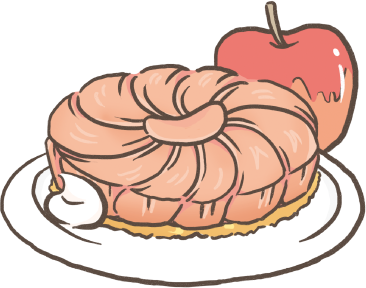
Copyright (C) 2014 nagashimashokuhin Co.,Ltd. All Rights Reserved.









